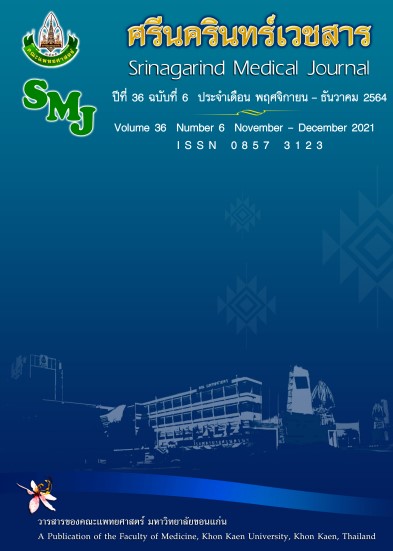Effects of HIV Risk Reduction Program on Condom Use, HIV infection, and Syphilis among Men Who Have Sex with Men and Transgender Women
Keywords:
Keywords: HIV risk reduction program; HIV infection; Syphilis; men who have sex with men; transgender womenAbstract
หลักการและวัตถุประสงค์: ปัจจุบันทั่วโลกพบการติดเชื้อเอชไอวีรายใหม่ในกลุ่มชายที่มีเพศสัมพันธ์กับชายและสาวประเภทสองเพิ่มขึ้น ประเทศไทยพบการติดเชื้อเอชไอวีในประชากรกลุ่มนี้สูง จากการประมาณการณ์ระหว่างปี 2559-2563 พบ ร้อยละ 53 รูปแบบการลดการติดเชื้อเอชไอวีโดยแกนนำให้ข้อมูลและปรับเปลี่ยนพฤติกรรมเสี่ยงทางเพศ เป็นรูปแบบที่ใช้กันแพร่หลายในทางสาธารณสุข การศึกษาเชิงทดลองนี้วัตถุประสงค์เพื่อศึกษาผลของโปรแกรมลดพฤติกรรมเสี่ยงต่อการใช้ถุงยางอนามัย ความรู้เกี่ยวกับการใช้ถุงยางอนามัย การติดเชื้อเอชไอวี และซิฟิลิสในกลุ่มชายที่มีเพศสัมพันธ์กับชายและสาวประเภทสอง
วิธีการศึกษา: อาสาสมัครคือ ชายที่มีเพศสัมพันธ์กับชายและสาวประเภทสอง จำนวน 80 ราย สุ่มโดยจับฉลากเข้ากลุ่มทดลองและควบคุม กลุ่มละ 40 ราย เก็บข้อมูล ที่โรงพยาบาลศรีนครินทร์ ระหว่างเดือน มิถุนายน 2562 - กันยายน 2563 กลุ่มควบคุมได้รับการพยาบาลตามปกติ 6 เดือน กลุ่มทดลองได้รับการการพยาบาลตามปกติร่วมกับได้รับโปรแกรมลดพฤติกรรมเสี่ยงต่อการติดเชื้อเอชไอวีแบบกลุ่ม 4 ครั้ง วิเคราะห์ข้อมูลโดยใช้ความถี่ ร้อยละในข้อมูลส่วนบุคคลและวิเคราะห์สัดส่วนความแตกต่างอัตราการใช้ถุงยางอนามัย การติดเชื้อเอชไอวีและซิฟิลิสโดยใช้สถิติ z test และความแตกต่างค่าเฉลี่ยของคะแนนความรู้เกี่ยวกับการใช้ถุงยางอนามัย ระหว่างกลุ่มควบคุมและกลุ่มทดลอง โดยใช้ t-test
ผลการศึกษา: อัตราการใช้ถุงยางอนามัยและความรู้เกี่ยวกับการใช้ถุงยางอนามัยในกลุ่มที่ได้รับโปรแกรมลดพฤติกรรมเสี่ยงต่อการติดเชื้อเอชไอวีสูงกว่ากลุ่มที่ไม่ได้รับโปรแกรมฯ อย่างมีนัยสำคัญทางสถิติ (p<.001, p<.05) การติดเชื้อซิฟิลิสในกลุ่มที่ได้รับโปรแกรมฯ ต่ำกว่ากลุ่มกลุ่มที่ไม่ได้รับโปรแกรมฯ อย่างมีนัยสำคัญทางสถิติ (p<.05) การติดเชื้อเอชไอวี ในกลุ่มที่ได้รับโปรแกรมฯ ต่ำกว่ากลุ่มที่ไม่ได้รับโปรแกรมฯ อย่างไม่มีนัยสำคัญทางสถิติ (p>.05)
สรุป: โปรแกรมลดพฤติกรรมเสี่ยงต่อการติดเชื้อเอชไอวีในชายที่มีเพศสัมพันธ์กับชายและสาวประเภทสอง สามารถเพิ่มอัตราการใช้ถุงยางอนามัย ลดการติดเชื้อซิฟิลิสได้อย่างมีนัยสำคัญ ควรใช้โปรแกรมฯ กับประชากรกลุ่มนี้เพื่อเพิ่มการใช้ถุงยางอนามัยและป้องกันซิฟิลิส
คำสำคัญ: โปรแกรมลดพฤติกรรมเสี่ยง; การติดเชื้อเอชไอวี ซิฟิลิส; ชายที่มีเพศสัมพันธ์กับชาย;
สาวประเภทสอง
Background and objective: Globally new HIV infection rates are increasing among men who have sex with men (MSM) and transgender women (TGW). In Thailand new HIV infection rates in these populations are high with an estimated 53% increase in new HIV infections between 2016-2020. HIV risk reduction approaches using peer-provided HIV and sexual-risk behavior information are now widely implemented in public health. This study aimed to determine the effects of an HIV risk reduction program on condom use, knowledge about condom use, HIV infection, and Syphilis among MSM and TGW.
Methods: Participants were 80 MSM and TGW randomly assigned to a control, or, experimental group with 40 cases in each group. Data were collected in Srinagarind Hospital, Khon Kaen University, between June 2019 and September 2020. The control group received regular nursing care and the experimental group received regular nursing care plus 4 monthly HIV risk reduction program sessions, with follow-up evaluation after 6 months. Descriptive data were analyzed using frequency and percentages. A z test of proportionality was used for condom use ratings, HIV infection and syphilis, and t test to compare knowledge about condom use between the 2 groups.
Results: Participants who received the HIV risk reduction program showed significantly higher rates of condom use and higher mean score of knowledge about condom use (p<0.001, P<0 .05) than the control group. They also had significantly lower syphilis infection rates than the control group (p<.05), but not significantly lower HIV infection rates(p>0.05).
Conclusions: An HIV risk reduction program for MSM and TGW was shown to significantly increase condom use and decrease syphilis infection rates compared to controls. . The application of this HIV risk reduction program for MSM and TGW holds promise for increasing condom use and decreasing syphilis infection in these groups.
Keywords: HIV risk reduction program; HIV infection; Syphilis; men who have sex with men; transgender women




